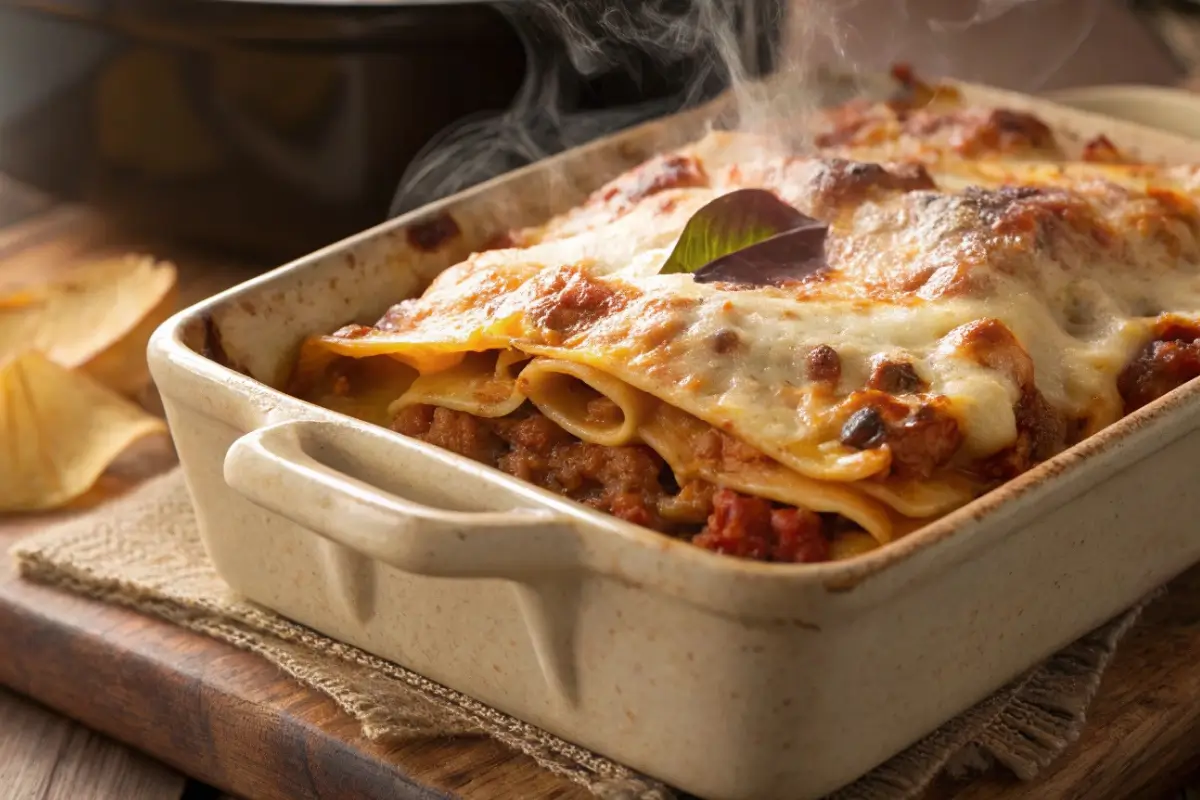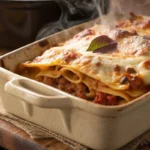There’s something magical about the smell of a bubbling classic homemade lasagna baking in the oven. It’s the kind of dish that stops conversations, brings people to the table, and leaves no leftovers behind. Whether you’re cooking for a family dinner, prepping for guests, or just treating yourself to a timeless Italian comfort dish, this recipe promises rich layers of cheesy, meaty, saucy goodness that satisfy every time.
In this article, we’ll walk you through every aspect of making the perfect classic homemade lasagna—from selecting ingredients to storing leftovers. You’ll find step-by-step instructions, helpful tips, delicious variations, and answers to the most commonly asked lasagna questions.
Looking for inspiration? Try Salisbury Steak with Mushroom Gravy – The Ultimate Comfort Food Classic for another cozy dinner idea.
Jump tp:
Why You’ll Love This Classic Homemade Lasagna
What Makes Classic Homemade Lasagna So Special
At its core, classic homemade lasagna is all about hearty comfort and timeless tradition. It combines tender pasta sheets, rich meat sauce, and layers of creamy cheese, all baked until beautifully golden. What makes it special is not just the ingredients but the love and patience behind each layer.
Unlike quick pasta dishes, lasagna is a meal that shows effort—and it always pays off. It’s a dish with heritage, rooted in Italian kitchens and passed down through generations. The result? A bite that’s loaded with nostalgia, flavor, and satisfaction.
Traditional Flavors and Timeless Appeal
One reason why people adore classic homemade lasagna is because of its deep, balanced flavors. The blend of ground beef, onions, garlic, tomatoes, and Italian herbs creates a sauce that simmers to perfection. Then comes the ricotta or cottage cheese layer—creamy and smooth—balanced by the stretch and melt of mozzarella.
This dish is versatile too. Want to add spinach? No problem. Prefer cottage cheese over ricotta? Go for it. You can make it your own without losing that traditional appeal. It’s no wonder lasagna remains a Sunday dinner staple across so many households.
Don’t miss our guide on Sweet Chili Halloumi Wraps: The Ultimate Tangy-Crispy Wrap Experience for a fresh and bold take on lunch recipes.
Preparation and Cooking Time
Total Time Breakdown (Prep, Cook, Rest)
Making classic homemade lasagna from scratch might take a bit longer than a quick weeknight meal, but every minute is worth it. Here’s a breakdown of what you can expect:
| Task | Time |
|---|---|
| Prep Time | 30 minutes |
| Cook Time | 1 hour |
| Resting Time | 15 minutes |
| Total Time | 1 hour 45 minutes |
This gives the lasagna time to develop its flavors and helps it set properly before serving. The prep involves simmering the meat sauce, boiling pasta (if not using no-boil noodles), and assembling everything in layers.
Even though it takes almost two hours from start to finish, much of that time is hands-off. While it bakes, you can clean up, prepare sides, or just relax with a glass of wine.
How to Make It Efficiently on Busy Weeknights
Pressed for time? Here are smart ways to enjoy classic homemade lasagna without the stress:
- Make Ahead: Prepare the sauce and cheese mixture a day in advance. You can even assemble the lasagna and refrigerate it overnight before baking.
- Use No-Boil Noodles: Save a pot and extra minutes by using oven-ready pasta sheets.
- Freeze in Portions: Make a large batch and freeze individual servings. Just reheat and enjoy anytime.
- One-Pan Strategy: Consider using a deep casserole dish that goes from oven to table, cutting down cleanup time.
Discover great ideas like our Heavenly Boston Cream Pie Cheesecake if you’re planning ahead for a dessert to pair with dinner.
Time management is key when making something this rich and satisfying. With a little prep, your classic homemade lasagna can be both a weeknight win and a dinner party centerpiece.
Ingredients
Core Ingredients for Authentic Flavor
When it comes to classic homemade lasagna, the secret is using high-quality, fresh ingredients. This isn’t the time to skimp—each layer depends on rich, bold flavors that come together in the oven. Below is everything you need to build the best traditional lasagna:
| Ingredient | Quantity | Notes |
|---|---|---|
| Ground beef | 1 lb | Lean, 85% or higher |
| Italian sausage | ½ lb | Adds depth and seasoning |
| Onion | 1 medium, diced | Sautéed for sweetness |
| Garlic | 3 cloves, minced | Boosts the base flavor |
| Crushed tomatoes | 28 oz can | Unsweetened, high-quality |
| Tomato paste | 6 oz | For rich, concentrated sauce |
| Ricotta cheese | 15 oz | Or substitute with cottage cheese |
| Mozzarella cheese | 2 cups shredded | Freshly shredded melts better |
| Parmesan cheese | ½ cup grated | Adds sharpness |
| Lasagna noodles | 12 sheets | Boiled or oven-ready |
| Egg | 1 large | Binds the ricotta layer |
| Italian seasoning | 2 tsp | Oregano, basil, thyme |
| Olive oil | 2 tbsp | For sautéing vegetables |
| Salt and pepper | To taste | Season all layers |
Substitutes and Add-Ons to Consider
Making adjustments for dietary needs or personal taste? No problem. Here are some recommended substitutes and delicious additions to personalize your classic homemade lasagna:
- Cottage cheese vs. Ricotta: If you’re after a lighter texture and slightly tangier flavor, cottage cheese is a great stand-in.
- Gluten-free noodles: Perfect for guests with gluten sensitivities—just cook carefully as they’re more fragile.
- Spinach or kale: Stir chopped greens into your ricotta mix for added nutrients and color.
- Mushrooms or zucchini: Great veggie add-ins that won’t overpower the meat sauce.
- Red pepper flakes: For a little heat in the sauce.
Don’t miss our Berry Cheesecake Bites if you’re planning a sweet and simple finish to a hearty meal.
The beauty of this recipe is that it’s endlessly customizable. Stick to the basics or go bold with your own spin—the core of classic homemade lasagna remains comfort in every bite.
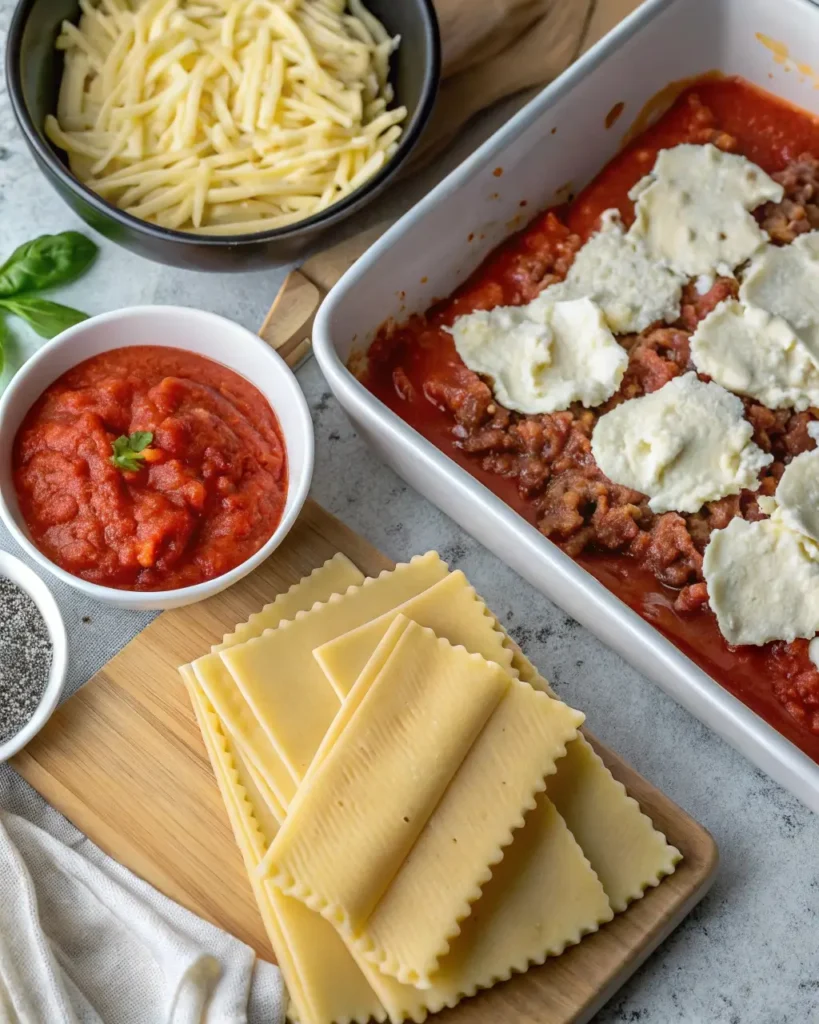
Step-by-Step Instructions
Prepping the Meat Sauce and Noodles
To build rich, deep flavor in your classic homemade lasagna, it starts with the meat sauce. This step infuses the dish with hearty, savory notes and sets the foundation for every layer.
1. Sauté the Aromatics
In a large skillet, heat olive oil over medium heat. Add diced onions and sauté until translucent—about 5 minutes. Stir in the minced garlic and cook for another minute.
2. Brown the Meat
Add ground beef and Italian sausage. Break up the meat as it cooks until no pink remains. Drain excess fat for a lighter sauce.
3. Build the Sauce
Pour in crushed tomatoes and tomato paste. Stir in Italian seasoning, salt, pepper, and a pinch of sugar to balance acidity. Simmer uncovered for 20–25 minutes, stirring occasionally, until the sauce thickens beautifully.
4. Prepare the Noodles
Boil the lasagna noodles in salted water according to package directions—or skip this step if you’re using oven-ready sheets. Lay cooked noodles flat on parchment or a damp cloth to avoid sticking.
Assembling Layers the Right Way
Now comes the fun part—layering your classic homemade lasagna! This is where you build flavor, texture, and that gorgeous golden top.
1. Spread Sauce on the Base
Start by adding a thin layer of meat sauce to the bottom of a greased 9×13-inch baking dish. This prevents noodles from sticking and adds moisture from the bottom up.
2. Layer 1: Noodles + Ricotta Mix
Add a layer of lasagna noodles, slightly overlapping. In a bowl, combine ricotta cheese, one egg, and a pinch of salt. Spread half of this mixture evenly over the noodles.
3. Layer 2: Meat Sauce + Mozzarella
Top with a generous layer of meat sauce, followed by a hearty sprinkle of shredded mozzarella.
4. Repeat Layers
Repeat steps 2 and 3. You should end with a final noodle layer, topped with remaining sauce, mozzarella, and Parmesan.
5. Bake to Perfection
Cover the dish with foil and bake at 375°F (190°C) for 30 minutes. Then remove the foil and bake for another 15 minutes or until the cheese is bubbling and slightly golden.
6. Let It Rest
Remove the lasagna from the oven and let it sit for 15–20 minutes before slicing. This allows it to firm up and makes cutting easier.
Check out this comfort favorite’s cousin: Ambrosia Salad Recipe for a cool, creamy side that pairs surprisingly well.
Each step in building classic homemade lasagna is a small investment in big flavor. Taking the time to prepare every layer just right results in a dish that’s not only satisfying—it’s unforgettable.
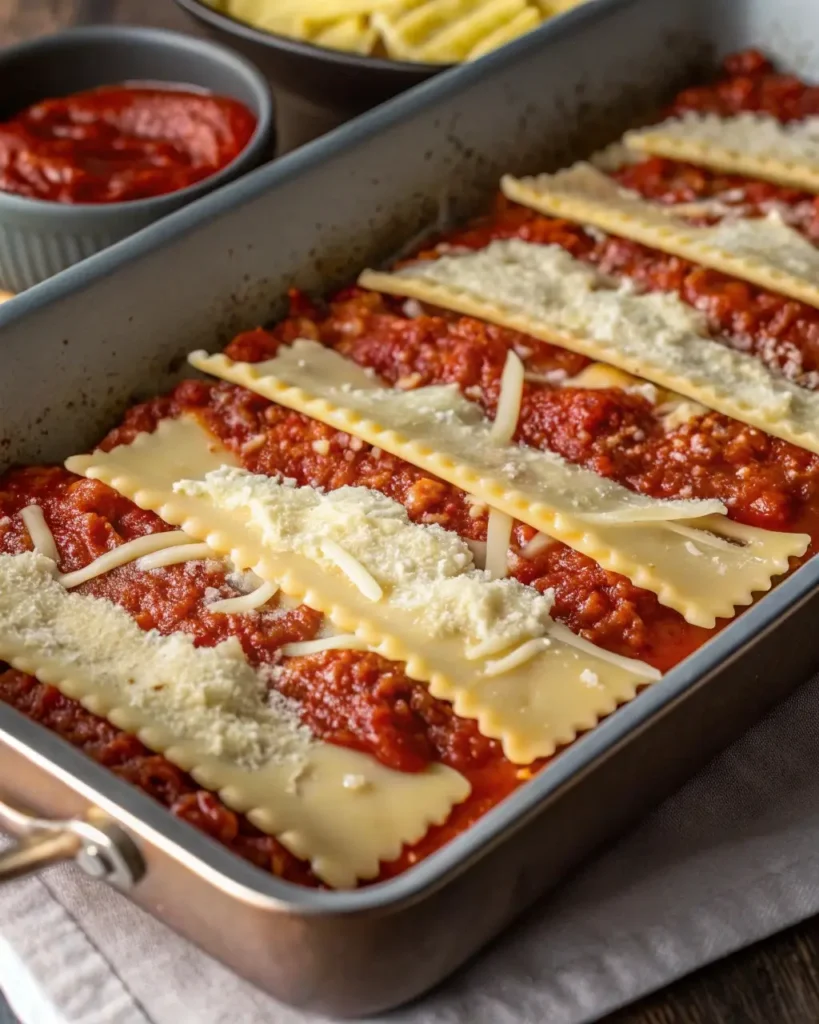
How to Serve
Pairing Lasagna with Sides and Drinks
Once your classic homemade lasagna is hot, bubbly, and resting on the counter, it’s time to think about how you’re going to serve it. This dish is hearty and rich, so pairing it with fresh, light, or acidic sides helps balance each bite.
Here are some all-time favorite lasagna pairings:
| Side Dish | Why It Works |
|---|---|
| Garlic Bread or Breadsticks | Great for scooping sauce and cleaning plates |
| Caesar or Garden Salad | Adds freshness and crunch |
| Roasted Vegetables | Complements richness without overpowering |
| Caprese Salad | Classic tomato-basil pairing |
| Italian Wedding Soup | Cozy and broth-based to contrast layers |
And for drinks:
- Red wine: A bold Chianti or Merlot is a perfect pairing
- Sparkling water with lemon or lime
- Iced tea with a splash of citrus
- Grape juice for a non-alcoholic complement
Want something sweet to follow up this indulgent main? Don’t miss our Tzatziki Chickpea Salad as a refreshing pre- or post-lasagna option.
Presentation Tips for Family Dinners or Guests
Presentation is simple with classic homemade lasagna—but you can elevate it with a few small touches:
- Garnish with fresh basil or parsley right before serving for color and flavor.
- Use a sharp knife and pie server for clean cuts and stacked slices.
- Serve in pre-heated plates so the lasagna stays warm longer at the table.
- Add a sprinkle of grated Parmesan and cracked black pepper for extra flair.
A well-plated piece of lasagna makes your homemade effort feel like a restaurant-quality experience. Whether it’s a holiday, birthday, or just a cozy Sunday night, taking a few extra minutes to serve it right goes a long way.
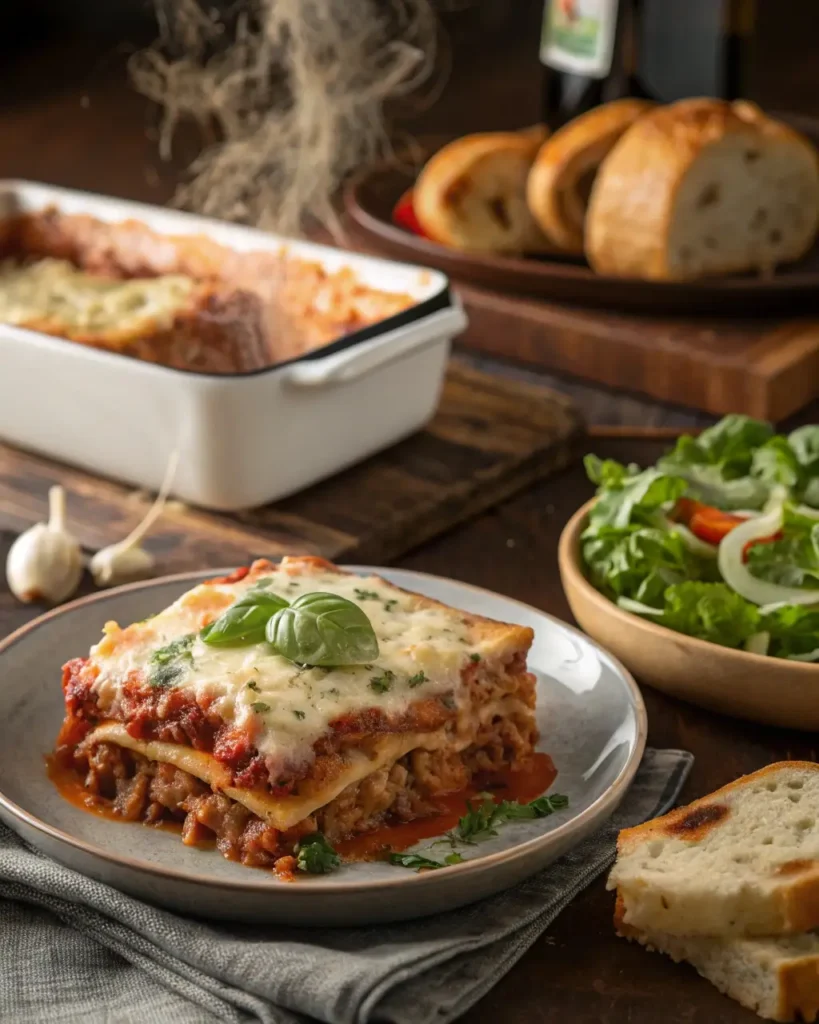
Discover more cozy comfort recipes like our Roasted Veggie Hummus Bowl—an easy side or next-day lunch idea.
Additional Tips for Perfect Lasagna
Preventing Soggy Layers and Burnt Tops
Making classic homemade lasagna isn’t complicated, but a few small missteps can turn your masterpiece into a mess. Here’s how to avoid common lasagna pitfalls and ensure each layer is luscious, not mushy or dry:
1. Drain the meat well
Greasy meat leads to an oily, slippery texture. After browning the ground beef and sausage, drain excess fat before adding tomatoes.
2. Simmer your sauce
A watery sauce soaks into noodles and causes sogginess. Let it simmer uncovered to reduce and concentrate the flavors. It should coat a spoon—not run off it.
3. Go easy on the ricotta layer
Too much moisture in the cheese layer can ruin the structure. Mix in an egg to help it set and hold its shape.
4. Use enough noodles
Don’t skimp on the pasta! Each layer of noodles adds stability and height to your classic homemade lasagna.
5. Bake with foil, then without
Start baking covered with aluminum foil to trap moisture and avoid over-browning. Uncover during the final 10–15 minutes to develop that beautiful golden crust.
Looking for inspiration? Try our Mediterranean Veggie Bowls as a wholesome, light contrast to this rich Italian bake.
How to Get That Golden-Bubbly Finish
One of the hallmarks of a great classic homemade lasagna is the golden, bubbling cheese topping. Here’s how to nail it:
- Use freshly shredded mozzarella: Pre-shredded versions often include anti-caking agents that prevent even melting.
- Top with Parmesan for texture: Grated Parm creates a crust that browns beautifully under heat.
- Broil briefly, if needed: If it’s not golden enough after baking, switch to broil for 2–3 minutes—but watch closely.
Want your lasagna to photograph as good as it tastes? Let it rest, slice with a clean knife, and serve with a sprig of fresh basil.
Recipe Variations of Classic Homemade Lasagna
Vegetarian and Gluten-Free Options
Don’t eat meat? Avoiding gluten? You can still enjoy the bold, rich flavors of classic homemade lasagna with a few smart swaps that keep it delicious and satisfying.
Vegetarian Lasagna Ideas
- Mushroom Spinach Lasagna: Use sautéed mushrooms and wilted spinach instead of meat. Add layers of zucchini or eggplant for texture.
- Three-Cheese Lasagna: Amp up the flavor with mozzarella, ricotta, and provolone. Add marinara instead of meat sauce.
- Lentil Lasagna: For a protein punch, swap ground meat for seasoned lentils in the tomato base.
Gluten-Free Lasagna Options
- Gluten-free lasagna noodles: Widely available in rice, corn, or quinoa varieties. Cook slightly under to prevent mushiness.
- Zucchini or Eggplant Sheets: Thin slices of roasted veggies can replace pasta entirely, giving your classic homemade lasagna a low-carb twist.
- Polenta Layers: For something unique, try thin layers of cooked polenta instead of noodles.
For more veggie-forward comfort dishes, don’t miss our Carrot Apple Salad Recipe—a great crunchy side to serve with any of these variations.
Meat Lovers vs. Cheese Lovers: Custom Tweaks
One of the joys of classic homemade lasagna is how easily it adapts to your preferences. Whether you love it extra meaty or piled high with cheese, here’s how to adjust:
Meat Lovers’ Lasagna
- Add pancetta or chopped bacon for smokiness.
- Use a combo of beef, pork, and veal for a true Bolognese-style depth.
- Increase the meat-to-sauce ratio for bold, dense layers.
Cheese Lovers’ Lasagna
- Add a béchamel sauce between layers for creamy richness.
- Use four cheeses: ricotta, mozzarella, Parmesan, and fontina.
- Add cottage cheese for a tangy, protein-rich boost.
Whether you’re feeding picky kids or a room full of guests, there’s a version of classic homemade lasagna that hits the spot.
Freezing and Storage
How to Freeze and Reheat Without Losing Texture
One of the best things about classic homemade lasagna is how beautifully it freezes. Whether you’re meal-prepping or saving leftovers, a few tricks can ensure it tastes just as fresh as the day you baked it.
To Freeze Before Baking
- Assemble completely in a freezer-safe dish.
- Wrap tightly with plastic wrap and foil to prevent freezer burn.
- Label with the date and baking instructions.
- Freeze for up to 3 months.
To Freeze After Baking
- Allow the lasagna to cool completely.
- Cut into portions for easy reheating.
- Wrap each piece individually or layer between parchment paper in a container.
Reheating Instructions
| Method | Time | Tips |
|---|---|---|
| Oven (whole) | 375°F for 60–75 mins | Cover with foil, then uncover for 10 mins |
| Oven (slice) | 375°F for 25 mins | Add a splash of water to maintain moisture |
| Microwave | 4–5 mins on medium | Use a microwave cover to avoid drying out |
You can keep frozen classic homemade lasagna tasting oven-fresh by letting it thaw overnight in the fridge before baking or reheating.
Looking for more freezer-friendly recipes? Check out our Cheesecake Brownies—they freeze like a dream and are great for prepping dessert in advance.
Storage Tips to Keep It Fresh for Days
In the Fridge
- Store covered in an airtight container.
- Keeps fresh for 3 to 5 days.
- Reheat in the oven or microwave for best results.
On the Counter? No!
Lasagna contains meat and dairy—never store it unrefrigerated for more than 2 hours.
Pro Tip: If your lasagna is too saucy, the noodles may soften too much with longer storage. Bake it a little under and reheat to perfection later.
Classic homemade lasagna isn’t just a meal—it’s a gift that keeps on giving when you know how to store and reheat it right.
Special Equipment for Making Lasagna
Must-Have Kitchen Tools
While you can make classic homemade lasagna with basic kitchen gear, having the right tools on hand makes the process smoother, quicker, and more enjoyable. Here’s what you’ll need to get started:
| Tool | Why It’s Essential |
|---|---|
| 9×13-inch baking dish | The perfect size for even layers |
| Large skillet or Dutch oven | For preparing the meat sauce with room to stir |
| Medium mixing bowls | Ideal for combining cheese mixtures |
| Silicone spatula | Makes spreading ricotta easy and mess-free |
| Sharp knife | For clean slices that keep layers intact |
These basics help you layer confidently, cut clean portions, and manage hot ingredients without spills or burns.
If you’re just starting out, keep it simple with a glass or ceramic dish, a wooden spoon, and a bit of patience—you’ll still end up with an amazing classic homemade lasagna.
Upgrades That Make Cooking Easier
Want to take your lasagna-making game to the next level? These upgraded tools can help you cook faster and cleaner while giving your dish a professional finish:
- Lasagna pan with higher sides: Prevents bubbling sauce from spilling over.
- Offset spatula: Great for spreading sauce and cheese into corners.
- Mandoline slicer: If you’re using veggies instead of noodles, this tool guarantees even, thin slices.
- Digital thermometer: Ensures the center of your lasagna reaches a safe and hot 165°F before serving.
- Freezer-safe, oven-to-table bakeware: Make, store, freeze, and serve—all in one pan.
Don’t miss our Tiramisu Cheesecake for another rich Italian-inspired dish where presentation matters just as much as flavor.
Investing in the right equipment makes preparing classic homemade lasagna more efficient and enjoyable, especially if it’s a dish you love to serve often.
Frequently Asked Questions
What is in a traditional lasagna?
A traditional classic homemade lasagna includes layers of pasta, rich meat sauce (usually a blend of ground beef and pork), ricotta cheese mixed with egg, shredded mozzarella, grated Parmesan, and a perfectly balanced tomato base. The structure typically follows a sauce-noodle-cheese pattern, repeated for two or three layers.
This dish is famous for its savory, comforting flavor and its ability to feed a crowd while still tasting like a labor of love.
What is the secret to a good lasagna?
The secret to a great classic homemade lasagna lies in patience and balance. Simmering your meat sauce for 20–30 minutes deepens flavor. Mixing ricotta with egg gives it structure. And resting the lasagna after baking helps layers firm up and flavors meld.
Use high-quality ingredients and don’t rush the process—lasagna rewards care and time.
What are the layers of traditional lasagne?
Classic lasagna is typically structured like this:
Meat sauce on the bottom
Lasagna noodles
Ricotta cheese mixture
Meat sauce
Mozzarella
Repeat layers
Top with final noodles, sauce, and cheese blend
This structured layering creates the signature taste and texture of classic homemade lasagna, with every bite offering a perfect mix of ingredients.
Do Italians in Italy use ricotta in lasagna?
Yes and no—it depends on the region. In Southern Italy, especially in Naples and Sicily, ricotta is traditionally used in lasagna. In Northern Italy, béchamel sauce (a white, creamy sauce made from butter, flour, and milk) is more common.
In American-style classic homemade lasagna, ricotta is the standard, often blended with egg and herbs.
Is lasagna better with ricotta or cottage cheese?
That comes down to taste and texture. Ricotta offers a smooth, creamy consistency with mild flavor—ideal for the soft, comforting layers of classic homemade lasagna. Cottage cheese, on the other hand, has a slightly tangier profile and curdled texture that some people love for its contrast.
Either option works well, and both are often interchangeable in lasagna recipes.
What to add to lasagna to make it taste better?
There are several ways to elevate the flavor of classic homemade lasagna:
Add a pinch of red pepper flakes or chili powder for mild heat
Splash in a bit of red wine to deepen the sauce
Stir in fresh basil or oregano for aromatic complexity
Add grated nutmeg to the cheese mixture for a subtle warmth
Use a blend of ground beef and pork for more flavor depth
Even a small tweak to the sauce or cheese layer can make your lasagna stand out at the table.
Looking for more family-favorite recipes? Don’t miss our Ambrosia Salad Recipe—a great sweet contrast to a savory main like lasagna.
Conclusion
There’s a reason classic homemade lasagna has stood the test of time. It’s rich, layered with flavor, and deeply comforting—a dish that feels like a hug from the inside out. Whether you’re making it for a special family dinner, freezing portions for easy weeknight meals, or simply craving the warm nostalgia of a traditional Italian meal, this recipe delivers every time.
From selecting fresh ingredients to perfecting the layering and mastering the bake, every step plays a part in achieving that golden, bubbly perfection. And the best part? Once you’ve made it a few times, you’ll start to add your own signature twist.
So, pull out your baking dish, preheat that oven, and get ready to impress with a classic homemade lasagna that’s anything but ordinary.
Don’t miss our guide to How Long to Cook Enchiladas if you’re into more saucy, baked favorites from different cuisines.
PrintClassic Homemade Lasagna
This classic homemade lasagna is a comforting Italian favorite, layered with rich meat sauce, creamy ricotta, and bubbly mozzarella. Perfect for family dinners, entertaining, or meal prep, this traditional recipe is easy to make and always a crowd-pleaser.
- Prep Time: 30 minutes
- Cook Time: 1 hour
- Total Time: 1 hour 45 minutes
- Yield: 8 servings
- Category: Main Course
- Method: Baking
- Cuisine: Italian
Ingredients
- 1 lb ground beef
- ½ lb Italian sausage
- 1 medium onion, diced
- 3 garlic cloves, minced
- 28 oz crushed tomatoes
- 6 oz tomato paste
- 2 tsp Italian seasoning
- Salt and black pepper to taste
- 2 tbsp olive oil
- 15 oz ricotta cheese
- 1 egg
- 2 cups shredded mozzarella cheese
- ½ cup grated Parmesan cheese
- 12 lasagna noodles (boiled or oven-ready)
Instructions
- In a large skillet, heat olive oil over medium heat. Sauté diced onions until soft, then add garlic and cook for another minute.
- Add ground beef and Italian sausage. Cook until browned, then drain excess fat.
- Stir in crushed tomatoes, tomato paste, Italian seasoning, salt, and pepper. Simmer uncovered for 20–25 minutes until thick.
- Boil lasagna noodles as per package instructions, or prepare oven-ready noodles.
- In a bowl, mix ricotta cheese with the egg and a pinch of salt.
- Preheat oven to 375°F (190°C). Grease a 9×13-inch baking dish.
- Spread a layer of meat sauce on the bottom, then layer noodles, ricotta mixture, meat sauce, mozzarella. Repeat for two layers.
- Top the final layer with remaining sauce, mozzarella, and Parmesan cheese.
- Cover with foil and bake for 30 minutes. Remove foil and bake another 15 minutes until cheese is golden.
- Let rest 15 minutes before serving.
Notes
- You can substitute ricotta with cottage cheese for a lighter texture.
- For vegetarian versions, replace meat with mushrooms or lentils.
- Store leftovers in the fridge for 3–5 days or freeze for up to 3 months.
- Let frozen lasagna thaw overnight in the refrigerator before reheating.

